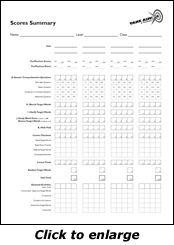Take Aim Semi-Independent Format Teacher Responsibilities
Take Aim Semi-Independent Format: Monitoring student performance
2289 Views
Once students begin working in the Take Aim! at Vocabulary program, it is important to monitor performance and adjust the program to maximize their success. Use all of the information available to you to determine how your students are progressing, including classroom observation, scores on activities and posttests, and target graphs.
It is especially important to ensure that students are spending their time appropriately. If students are spending time inappropriately, modify the steps for them. For example, if students spend a lot of time sketching detailed pictures for the Sketch Target Words section, you may require that they write a word or phrase instead of sketching a picture or have them use timers to allow one minute per sketch.
If a student isn't making the progress you expect while working in Take Aim, ask yourself the following questions:
- How does the student spend time? Too much time waiting? Too much time sketching the pictures? Too much time on additional activities?
- Is the level of material appropriate?
- How is the student's attendance and health?
Then choose an appropriate intervention.
USING THE SCORES SUMMARY
Using the scores summary to record a student's point totals will help you monitor whether he or she is improving from unit to unit. You may also use this form to look for patterns in the student's work.
This form allows you to record data for four units at a time. At lesson checkout, note whether the student completed the activities correctly, and check the student's responses to the questions against the unit answer key. Each correctly completed question or activity is worth one point. Note that the student gets one point for each word he or she sketches correctly, one point for each question he or she answers correctly, and so on.
When you check the student out of a unit, you can add the total number of points the student received for the unit. If a student completes a unit perfectly, he or she will score 102 points. If you use the optional activities, you may score these how you see fit and add points to the total. You will also record the student's pretest and posttest scores and dates on the scores summary, but these scores do not count toward the student's point total.
The Answer Comprehension Questions section of the scores summary provides spaces for you to record how the student did on each type of question (main idea, detail, vocabulary in context, and inferential). This information will help you look for patterns and know which area(s) of comprehension to work on with certain students. For example, you may notice that a student consistently has trouble answering the main idea comprehension question. In this case, you could work on that skill.
Similarly, the Lesson Checkout section of the form provides spaces for you to record whether or not the student passed on each item (read target words, read story fluently, defined target words, and completed activities) in his or her first checkout attempt. If you add a fluency component to your Take Aim program, you may record students' words correct per minute scores in this section.
See the Key Features section of the Take Aim Teacher's Manual for a description of this form.
Please let us know what questions you have so we can assist. For Technical Support, please call us or submit a software support request.
